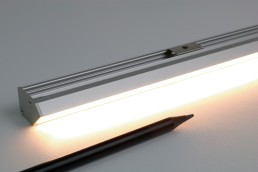
Less is More with David Morgan
The latest discreet architectural lighting fixture from KKDC, produced earlier this year, is the TANA Asymmetric. David Morgan puts the angled linear luminaire under the microscope.
KKDC has always focused on the ‘less is more‘ approach to luminaire design, with the development of miniature linear LED lighting systems for installation into discreet architectural details for high end projects.
The company was founded in 2005 by Jack Choo, who first encountered LEDs in the early 2000s while working for Toyoda Gosei in technical sales. He was able to persuade Samsung to use blue LEDs for mobile phone keypad back lights. In 2003, Jack and his brother Konkuk started a company to produce their own innovative LED arrays from scratch. Moving to Sydney, Australia in 2005, he founded KKDC to focus on the architectural lighting market. The company has since grown significantly with worldwide sales and a staff of around 100 people.
Research, development, and manufacturing take place at the KKDC R&D Centre in Seoul, South Korea. The company has 19 branch offices in major markets including a marketing and design office in the UK.
The first three KKDC systems, launched in 2005 and 2006: TIMI, MIMI and MOMO established the market niche for the company with small, well-engineered products for both interior and exterior applications. The 6mm wide Groove system was developed more recently based on a request from Philippe Starck as part of a hotel project to illuminate whisky shelving with the smallest dot free output luminaires.
The latest system introduced by KKDC earlier this year is the TANA Asymmetric.
The product name derives from the Japanese word for shelf and the original TANA system was an angled linear luminaire, designed by Tim Young from the KKDC Design House in the UK, for shelf illumination.
Apparently research with architects early in the life of KKDC had identified linear shelf lighting as a good potential market application that seems to have been an accurate prediction.
The TANA Asymmetric range incorporates a faceted extruded housing design with useful internal space for through wiring and connectors, an asymmetric linear optic and a new high output LED light engine.
KKDC design and development is undertaken as a collaborative in-house effort, with engineering design at the R&D Centre in Seoul and design input from KKDC Design House in the UK, plus global market feedback from KKDC sales branches. Jack Choo oversees the whole process and makes final decisions about timing and project priorities.
For them, the most challenging part of the luminaire development was the custom asymmetric lens design. This was designed in-house by the KKDC optical engineering team in Korea. Based on the test sample I was given to review, they have been able to produce a good quality textured extruded lens that produces an asymmetric beam without any significant striations in the beam or any colour over angle distortions or colour shifts. The beam does seem to split slightly between the major asymmetric beam and a secondary more vertical one.
The complete product development process took around two years, with much of the time devoted to the linear lens design and development.
The KKDC A Line LED light engine incorporates mid power 94 CRI LEDs on a 4.8mm pitch and the luminaire produces up to 2,970lm with 3000K LEDs and a power consumption of 30W/m. The range includes 2700K, 3000K and 4000K LED options with three-step MacAdam’s colour binning. The system works with a remote 24 VDC power supply and dimming options include 1-10V, 1-10V, DALI and DMX. The cutting module for the light engine is 38.46mm.
The TANA luminaires are produced with a nicely finished anodised satin silver aluminium extrusion, with the matching end caps fixed with neat machine screws. Available lengths range from 90mm up to 1,013mm. Concealed stainless steel spring clips fix the system to the mounting surface invisibly.
The company manufactures most of its components in-house either in Korea or in the UK. Aluminium extrusions are made with recycled aluminium and KKDC is aiming to move towards a circular economy approach.
The KKDC A Line light engine are constructed with FR4 PCB material, which is bonded to the extruded aluminium heat sink. As the company is moving towards a circular economy approach, the PCB material may need to change to aluminium, which can be recycled and the fixing method changed to allow easier on-site replacement.
The TANA range is a good quality system with an impressive light output for its small size. The asymmetric distribution provides a useful punch for use in applications including retail and display where high ambient lighting levels are required.



